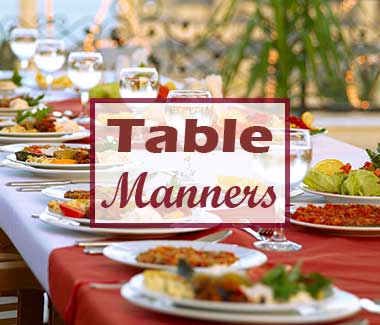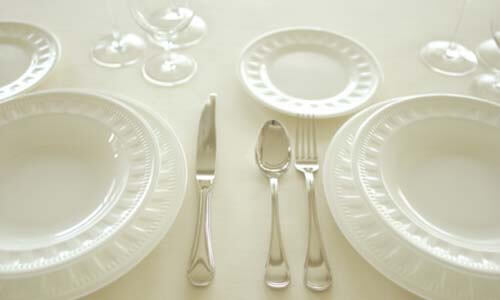Tablecloths
Table Setting Guide
The virtues of a tablecloth:
- The tablecloth is a decorative accessory that unifies the components of the table setting.
- A practical accoutrement that insulates the table and lowers the noise level in the room.
- And, Tablecloths provide more elbow room than placemats, and conserve space at a crowded table.
the right tablecloth
The five tablecoth design elements: dominance, visual weight, color, texture, and pattern.
dominance
Dominance refers to the prevailing design element. The right tablecloth accents the dominant color, pattern, and texture of the dinnerware and room décor.
visual weight
Visual weight relates to the proportions of the room.
Large Rooms. In a large room, to keep the table setting from looking lost, a tablecloth woven with big, compactly arranged patterns conveys visual weight.
Small Rooms. In a small room, lightness is suggested by a tablecloth woven with an airy pattern.
Color is a design tool that changes the mood of the table setting without changing the tableware.
Formal Dining. The colors of formal dining are white, ivory, and ecru (although pastel tablecloths sometimes appear on formal tables). But the ground color of the dinnerware and the tablecloth are not always the same. When one is ivory and the other is pure white, use them together, but for continuity match the color of the napkins to the tablecloth.
Informal Dining. The colors of informal dining are all shades, from bright to deep to contrasting, from metallic to pastel to white.
The texture of the tablecloth should relate to the finish of the tableware and also to the dining occasion.
Formal Dining. The textures of formal dining are smooth-porcelain, crystal, silver, finishes appropriate for a tablecloth woven with a satin sheen, such as damask.
Informal Dining. The textures of informal dining range from smooth to coarse.
Smooth weaves are compatible with fine surfaces, such as porcelain, bone china, ironstone, semiporcelain, silver, silver plate, and stainless steel.
Loosely woven heavy fabrics relate to coarse textures, such as pottery, stoneware, and pewter flatware.
The patterns of tablecloths range from large to small, bold to subtle, each design appropriate for a particular occasion.
Formal Dining. The patterns of formal dining are small and subtle, motifs that do not detract from the profusion of tableware.
Informal Dining. For informal dining in a dining room decorated with eye-catching wallpaper and boldly patterned upholstered pieces, a solid-covered tablecloth can be used to accent the decor. But in a room decorated with painted walls, or walls papered with a subtle design, and chairs upholstered with a small-scaled pattern, a tablecloth woven with a simple design underscores the setting.
decorative tips for tablecloths
The first purchase. A solid-color tablecloth is suggested for the first purchase, one that matches the dinnerware or accents the dinnerware in a contrasting color.
Variety. When the same tableware is used daily, vary the coverings to add interest to the settings.
Color mixing. Add a light-hearted touch to dining with a colorful mix of tablecloths and napkins, in complimentary hues and intensities.
The layered look. For decorative interest lay round or square tablecloths over circular cloths, and square cloths over oblong or oval tablecloths.
Open-weave table cloths. To emphasize the beauty of an open-weave pattern, accent the design with a colorful underliner in a shade that coordinates with the predominant hue of the dinnerware.
- Cool colors, such as blue or green, mix with dinnerware decorated with grayish hues.
- Warm colors, such as red or yellow, compliment dinnerware with yellowish undertones.
- Neutral colors, such as ivory, beige, or tan, are compatible with earth-tone dinnerware.
the length of the tablecloth overhang
The overhang is the distance between the top of the table and the hem of the tablecloth, a dimension that depends on the size of the table and the weight of the fabric.
In general, a lengthy table requires a long overhang and a small table a short drop. The guidelines are adaptable.
The average dining table is 27 inches high, and most chair seats are 16 ½ inches from the floor.
formal dinners
At a formal dinner the tablecloth overhang is luxurious and deep, approximately 10 to 15 inches, a drop that rests in the diner's lap and is tucked under the table before the napkin is lifted.
When a formal dinner is served at a number of tables, usually folding tables with metal legs are rented, covered with tablecloths that extend to the floor.
Because the menu at a formal luncheon is lighter than a formal dinner, the overhang of the tablecloth is shorter.
At a formal tea, most of the guests stand, and the overhang of the tablecloth can be up to 18 inches deep.
In a hotel or private club, when tea is served from a folding table, the tablecloth hangs to the floor to conceal the metal legs.
informal dinners
An informal dinner served at a smaller table is more relaxed than a formal affair, and the tablecloth overhang is several inches shorter, approximately 10 inches. But exceptions do exist:
- For some fabric, such as a lace tablecloth, the drop can be longer.
- Because no one sits at a buffet table, the overhang may be generous, even hanging to the floor.
the right size tablecloth
the size.
The size of the tablecloth is determined by the length and width of the dining table and the overhang on all four sides.
the shape.
A dining table extended by leaves changes shape; a round table becomes an oval, and a square table becomes a rectangle. The right size tablecloth is determined by the shape of the table that is used, and the addition or deletion of leaves calls for tablecloths of different sizes.
round tables
- Without Leaves
Round tables without leaves require round tablecloth.
Round table made for two to four people: 72-inch round tablecloth
Round table made for six to eight people: 86-to 90-inch round tablecloth
- With Leaves
Round tables with leaves require oval tablecloths
Round table extended to seat six people: 80-to 90-inch oval tablecloth
Round table extended to seat six to eight people: 102-to 108-inch oval tablecloth
Round table extended to seat ten to twelve people: 124-to 126-inch oval tablecloth
square tables
- Without Leaves
Square tables without leaves require square tablecloths
Square table made to seat four: 52-to 54-inch square tablecloth
- With leaves
Square tables with leaves require oblong tablecloth
Square table extended to seat two to four people: 70-inch oblong tablecloth
Square table extended to seat six people: 80-to 90-inch oblong tablecloth
Square table extended to seat eight to ten people: 102-to l08-inch oblong tablecloth
Square table extended to seat ten to twelve people: 124-to 126-inch oblong tablecloth
Square table extended to seat fourteen people: 144-inch oblong tablecloth
rectangular tables
Rectangular tables with or without leaves require oblong tablecloth in the same dimensions as mentioned for square tables
Oval tables without leaves require oval tablecloth
Oval table for four people: 70-inch oval tablecloth
Oval table for six people: 80-to 90-inch oval tablecloth
Oval table for eight to ten people: 102-to 108-inch oval tablecloth
Oval table for ten to twelve people: 124-to 126-inch oval tablecloth
Oval table for twelve to fourteen people: l44-inch oval tablecloth
To calculate the yardage for a tablecloth measure the length and width of the table, the overhang, the width of the seams, and the hem allowance.
silence cloth
To insulate against noise, a protective pad is laid under the tablecloth; this liner is known as a silence cloth.
The silence cloth is used to give the tablecloth a soft, drapey, luxurious appearance. This liner can be made of assorted materials, such as felt, an old wool blanket, a fluffy white fabric, or foam-backed vinyl cut to fit the table. Hard table pads made of layered insulation topped with aluminum foil and cotton flannel are available through department and specialty stores by custom order.
storing tablecloths
Wrap the tablecloth around a cardboard mailing tube that is as long as the tablecloth is wide. Or, fold the tablecloth in half and use a smaller tube (however, with this method the fabric may develop on the crease).
To prevent damage from smog and other contaminants in the air, store white, ecru, and ivory-colored tablecloths in blue acid-free tissue paper available at hand laundries. Man-made materials, such as plastic bags, trap moisture within and are not recommended for the storage of linens because they encourage the development of mildew and may change the color of the tablecloth.
Never store soiled linens; the stains set and with time are harder to remove.
ironing tablecloths
To touch up wrinkles with an iron, bring the ironing board to the end of the table and pull the cloth onto the table as it is ironed. Or cover the table with a heat-proof pad and iron the cloth on the table. To keep the cloth from getting dirty while it is being ironed, lay a sheet on the floor.
Seldom-used linens wrinkle when stored over a long period of time. It is easier to store them laundered, but unironed, rolled in a clean cotton sheet than to reiron them after storage.



